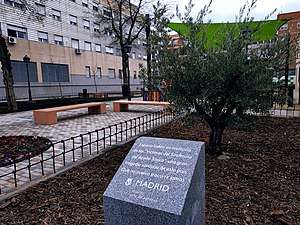Toxic oil syndrome
Toxic oil syndrome or simply toxic syndrome (Spanish: síndrome del aceite tóxico or síndrome tóxico) is a musculoskeletal disease most famous for a 1981 outbreak in Spain which killed over 600 people and is thought to have been caused by contaminated colza oil. Its first appearance was as a lung disease, with unusual features; though the symptoms initially resembled a lung infection, antibiotics were ineffective. The disease appeared to be restricted to certain geographical localities, and several members of a family could be affected, even while their neighbours had no symptoms. Following the acute phase, a range of other chronic symptoms was apparent.
| Toxic oil syndrome | |
|---|---|
 | |
| Plaque to the victims of the Toxic Oil Syndrome | |
| Specialty | Rheumatology |
Cause
The cause was traced to the consumption of colza oil that had been intended for industrial rather than food use.[1] To discourage human consumption, the oil was denatured by the addition of aniline to make it smell and taste bad. It was then imported as cheap industrial oil by the company RAPSA at San Sebastián, handled by RAELCA, and illegally refined by ITH in Seville to remove the aniline, resulting in a palatable product that could then be illegally sold. It was sold as "olive oil" by street vendors at weekly street markets, and was used on salads and for cooking. The commonly accepted hypothesis states that toxic compounds derived during the refinement process were responsible.
Once the origin of the syndrome was realised, public health officials organized an exchange programme, whereby those who had bought the oil could exchange it for pure olive oil, thereby quickly ending the outbreak.
Alternative mechanisms
The conclusion of the Joint WHO/CISAT Scientific Committee for the Toxic Oil Syndrome from 2002, that oil was the cause for TOS, is based only on epidemiological evidence, since up to now, experimental studies performed in a variety of laboratory animals have failed to reproduce the symptoms of human TOS.[2] None of the in vivo or in vitro studies performed with toxic-oil-specific components, such as fatty acid anilides, and esters of 3-(N-phenylamino)-1,2-propanediol (abbreviated as PAP), have provided evidence that these markers are causally involved in the pathogenesis of TOS.[2]
Specifically, three possible causative agents of TOS are PAP (3-(N-phenylamino)-1,2-propanediol), the 1,2-dioleoyl ester of PAP (abbreviated OOPAP), and the 3-oleoyl ester of PAP (abbreviated OPAP). These three compounds are formed by means of similar chemical processes, and oil that contains one of the three substances is likely to contain the other two.[2] Oil samples that are suspected to have been ingested by people who later developed TOS often contain all three of these contaminants (among other substances), but are most likely to contain OOPAP.[2] However, when these three substances were given to laboratory animals, OOPAP was not acutely toxic, PAP was toxic only after injection, but not after oral administration, and OPAP was toxic only after injection of high doses.[2] Therefore, none of these three substances is thought to cause TOS.[2] Similar results were obtained after administration of fatty acid anilides.[2]
Data discrepancies combined with both a high level of secrecy surrounding the huge investigation and the fact that the first cases of the syndrome were located in Madrid (near the U.S. military base in Torrejón de Ardoz) spread the idea of a conspiracy. Several of those affected by TOS claim they never consumed any of the tainted oil products. Furthermore, the tainted oil was primarily sold in low-cost street markets; yet, a considerable percentage of the patients were wealthy. Another theory suggests the toxic reaction was triggered by organophosphate poisoning (e. g., from pesticide residues in tomatoes) and covered up by the Spanish government and the WHO.[3]
See also
- Eosinophilia-myalgia syndrome
- Health crisis
- List of food contamination incidents
- Ginger Jake
References
- "A Long Trial in Spain on Fatal Tainted Food". New York Times. August 2, 1987.
- Toxic Oil Syndrome - 10 Years of Progress
- Woffinden, Bob (August 25, 2001). "Cover-up". The Guardian. London. Retrieved December 2, 2016.
External links
| Classification |
|---|